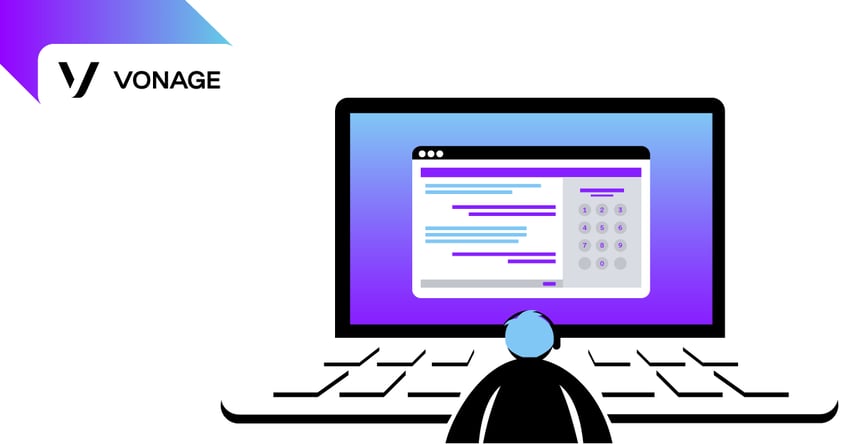What Is VoIP? A Look at Voice Over IP in Business
What is VoIP? While the basic idea behind voice over IP for businesses — a phone service delivered via data connection (e.g., the internet) instead of dedicated PBX hardware — is fairly simple to grasp, its ability to replace the PBX standard is the true story here.

Its flexibility, scalability, and overall value have made VoIP an industry unto itself — in fact, it’s projected to rake in about $15 billion in 2021. Let's take a deeper look at Voice over IP for business, starting with the basics.
What Is VoIP?
VoIP stands for voice over internet protocol, or voice over IP. These four words give a clear explanation of what’s at play: voice signals transmitted over an internet line instead of a dedicated phone line or phone hardware.
How Does VoIP Work and How Has It Evolved?
VoIP is digitized and delivered via the cloud, which means VoIP tools can be built into an endless number of features. For example, VoIP technology may power a retailer's click-to-call-now button, or make it possible for an on-the-go sales representative to use the same number at the desk and in the field.
However, the earliest takes on the technology looked little like the high-powered voice over IP tools businesses can access today. Early VoIP only worked online and required both the caller and the recipient to have the same software installed for communication to be possible. This meant, among other things, a landline couldn't call a VoIP line. While useful enough, this lack of capability essentially meant the technology wasn't fully there yet, and thus wasn't ready to be the dominant force in business communications it is today.
Over time, things have naturally gotten better — a lot better. Modern solutions are effectively indistinguishable from a legacy private branch exchange (PBX), and the cloud-based backend makes it even easier to tailor the system to the user's specific needs.
How Much Does Voice Over IP Cost?
There are a lot of variables to consider when it comes to cost, but the high-level answer is, not as much as you'd think — especially compared to a PBX setup with comparable functionality. VoIP usually starts at around $20 a month.
As a VoIP-for-business customer, you can break up the fees into two primary categories: upfront costs and monthly expenses. On the upfront side, you're looking at acquiring VoIP-compatible phones, computers, and other associated hardware, as well as installation fees and other one-time costs. For monthly expenses, you'll have your monthly bill and any recurrent IT support costs.
It's important to note here that VoIP is almost always less expensive than PBX, especially where international and long-distance calls are concerned. In fact, voice over IP in businesses got so big in part because all calls cost the same or come from the same bank of minutes.
What Are the Advantages of VoIP?
When you're asking "What is VoIP?," what you most likely really want to know is how it will benefit you — so let's talk about the upsides.
Cost: As noted above, costs are lower for long-distance calls and international communications. A VoIP minute is almost always going to cost significantly less than a PBX minute, and it remains the same no matter who you're calling.
Integrability: VoIP functionality can be built into mobile apps, backend software, existing platforms — basically any use case you can think of. It's also the backbone of exciting technologies like unified communications.
Flexibility: Likewise, because it's cloud-based, VoIP services can be scaled up and down at the click of a mouse — basically any use case you can think of, including VoIP call centers. Do you need to schedule a huge block of numbers to handle an anticipated influx of seasonal callers? You can usually provision them from an online portal in minutes. Do you need hundreds of phones active at a brand new location, pronto? If you've got an internet connection and a computer, you're off to a good start. It's that sort of flexibility that makes voice over IP in businesses a major force across all industries.
What Are the Disadvantages of VoIP?
Everything has tradeoffs, and VoIP is no different. While the technology is nearly as old as the internet itself and remarkably stable on today's high-bandwidth, low-latency networks, there are a few things businesses should take note of:
Dependence on internet: A VoIP line is ultimately only as reliable as the internet connection it runs on. If that connection is interrupted, the disruption will naturally carry over to the VoIP service as well, resulting in suboptimal call quality or outright interruption. However, technologies like SD-WAN, which "group" multiple data connections into a streamlined virtual network, can mitigate or outright remove this concern.
Quality of service: On a reliable, consistent connection, VoIP calls are indistinguishable from their landline counterparts. When problems do arise, however, they can result in audible issues like jitter, static, and lag.
In many cases, VoIP should work flawlessly in any business use case that would historically require the presence of PBX hardware. And it'll work just fine for other cases, such as executive desk lines and other top-priority communications. Just bear these points in mind as you consider installing or expanding VoIP service for your business, and you'll be ready to enjoy its benefits.